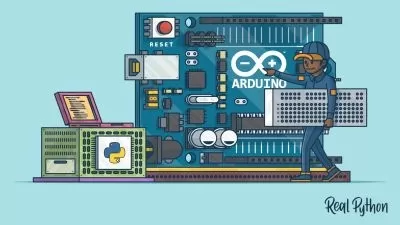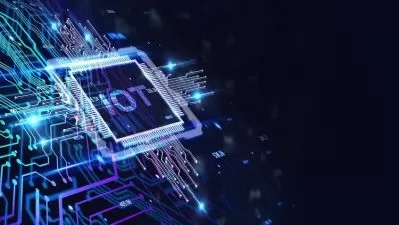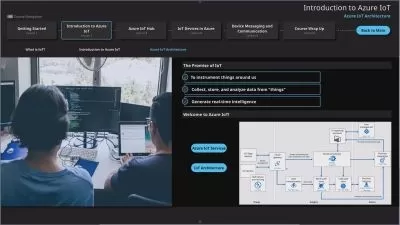Arduino IoT Environment Monitor Project
Dr. Peter Dalmaris
3:08:19
Description
The perfect project for the new Arduino maker looking for a weekend IoT challenge.
What You'll Learn?
- How to create an Arduino IOT system.
- Intergrate sensors, LEDs, LCDs, and Wifi hardware.
- Create and interact with a mobile and web dashboard powered by Blynk.
- How to use the the DHT11 sensor.
- How to use the photoresistor.
- How to use the 2x16 LCD display using the 4-bit parallel connection method.
- How to use the ESP01S WiFi module with an Arduino Uno.
- How to configure the ESP01S Wifi module using its AT command set.
- How to use the above mentioned hardware within the limited resource constraints of the Arduino Uno.
- How to create an Arduino shield PCB in KiCad to replace the prototyping breadboard.
Who is this for?
More details
DescriptionWith this course, you will apply the knowledge you acquired from Arduino Step by Step Getting Started to create a simple Internet of Things device.
This course aims to give you the opportunity to complete your first Arduino project that is non-trivial, combines modern hardware and software components, and includes an Internet of Things element.
In designing this course, one of my core objectives was to make this project course small and focused in scope. With this project, I want to give you a quick win and bolster your confidence so that you will feel good about continuing with bigger and more complicated projects.
In this course, you will learn to use an Arduino Uno along with these peripherals:
The DHT11 sensor.
The photoresistor.
The 2x16 LCD display with the 4-bit parallel connection method.
The ESP01S WiFi module.
You will learn how to assemble those peripherals into a single circuit. You will also learn how to calculate the appropriate fixed resistor for the photoresistor so that light sensor readings are accurate.
On the software side of the project, you will learn how to write a sketch that:
Makes use of the peripherals within the limited resource constraints of the Arduino Uno.
Design a web and mobile dashboard that displays sensor data and controls the Arduino.
You will also learn how to power your Arduino motor project with one or two batteries to separate the Arduino and motor sub-circuits.
Hardware
Most of the hardware I used in this course is conveniently part of the "3 in 1 IoT/Smart Car/Learning Kit for Arduino" by Sunfounder.
This kit contains an Arduino Uno clone board, the sensors, the wifi module, assorted resistors, wires and the breadboard.
This hardware is not included in this course, and you must purchase it separately.
You can purchase these items as part of a kit sold by Sunfounder, or individually from your preferred retailer.
Before you purchase any hardware, please take a few minutes to watch the lecture, "Hardware and kit overview", where I discuss all hardware components needed in this course.
This course has a prerequisite: Arduino Step-by-Step Getting Started
This is not an introductory course.
You should know how to wire up simple circuits on a breadboard and upload a sketch to your Arduino.
You should be able to read and understand simple Arduino code, install external libraries to the Arduino desktop IDE, and know how to fix simple code bugs and wiring errors.
If you don't feel confident about the skills I described, I recommend that you complete my course Arduino Step by Step Getting Started before attempting this course.
Who this course is for:
- Post-beginner Arduino makers.
- Anyone looking for an opportunity to complete their first non-trivialArduino project.
- Anyone looking for a quick win and bolster their confidence.
With this course, you will apply the knowledge you acquired from Arduino Step by Step Getting Started to create a simple Internet of Things device.
This course aims to give you the opportunity to complete your first Arduino project that is non-trivial, combines modern hardware and software components, and includes an Internet of Things element.
In designing this course, one of my core objectives was to make this project course small and focused in scope. With this project, I want to give you a quick win and bolster your confidence so that you will feel good about continuing with bigger and more complicated projects.
In this course, you will learn to use an Arduino Uno along with these peripherals:
The DHT11 sensor.
The photoresistor.
The 2x16 LCD display with the 4-bit parallel connection method.
The ESP01S WiFi module.
You will learn how to assemble those peripherals into a single circuit. You will also learn how to calculate the appropriate fixed resistor for the photoresistor so that light sensor readings are accurate.
On the software side of the project, you will learn how to write a sketch that:
Makes use of the peripherals within the limited resource constraints of the Arduino Uno.
Design a web and mobile dashboard that displays sensor data and controls the Arduino.
You will also learn how to power your Arduino motor project with one or two batteries to separate the Arduino and motor sub-circuits.
Hardware
Most of the hardware I used in this course is conveniently part of the "3 in 1 IoT/Smart Car/Learning Kit for Arduino" by Sunfounder.
This kit contains an Arduino Uno clone board, the sensors, the wifi module, assorted resistors, wires and the breadboard.
This hardware is not included in this course, and you must purchase it separately.
You can purchase these items as part of a kit sold by Sunfounder, or individually from your preferred retailer.
Before you purchase any hardware, please take a few minutes to watch the lecture, "Hardware and kit overview", where I discuss all hardware components needed in this course.
This course has a prerequisite: Arduino Step-by-Step Getting Started
This is not an introductory course.
You should know how to wire up simple circuits on a breadboard and upload a sketch to your Arduino.
You should be able to read and understand simple Arduino code, install external libraries to the Arduino desktop IDE, and know how to fix simple code bugs and wiring errors.
If you don't feel confident about the skills I described, I recommend that you complete my course Arduino Step by Step Getting Started before attempting this course.
Who this course is for:
- Post-beginner Arduino makers.
- Anyone looking for an opportunity to complete their first non-trivialArduino project.
- Anyone looking for a quick win and bolster their confidence.
User Reviews
Rating
Dr. Peter Dalmaris
Instructor's Courses
Udemy
View courses Udemy- language english
- Training sessions 25
- duration 3:08:19
- Release Date 2023/05/05















